
EHR Integration & Data Security 101
White Paper
ABSTRACT
The U.S. healthcare market presents significant challenges for startups, with failure rates that exceed those of other industries. The digital healthcare startup failure rate stands at a staggering 98%, compared to the broader startup failure rate of 90%.
Alarmingly, 51% of digital healthcare startups do not survive beyond their first two years, while 75% of U.S.-based medical device startups fail to gain traction. These sobering statistics highlight the complexities of entering a market with stringent regulations, limited opportunities to pivot, and intense competition.
One of the primary reasons startups fail is poor market fit—an issue cited by 42% of failed businesses, according to CB Insights. Even the most innovative solutions will struggle to succeed if they fail to address a genuine and widespread problem. Simply put, if a startup develops a product that does not meet an unmet need, it will struggle to attract customers and sustain growth. In the healthcare sector, where compliance, security, and interoperability are non-negotiable, EHR integration and data security play a critical role in determining whether a startup thrives or becomes part of the failure statistic.
This white paper provides a comprehensive guide to navigating the complexities of EHR integration and data security. By understanding these essential elements, startups can enhance their market fit, align with provider needs, and ensure compliance with U.S. regulations. The strategies, integration approaches, and security measures outlined in this paper are designed to help digital health startups build solutions that not only work but are also indispensable to healthcare providers and patients alike.
PART 1: THE IMPORTANCE OF EHR INTEGRATION
A well-executed EHR integration strategy provides multiple benefits. It significantly enhances efficiency and productivity by reducing administrative burdens and optimizing healthcare operations. Seamless interoperability between systems enables better data exchange, which in turn improves clinical decision-making and patient outcomes. Establishing robust integration also strengthens market access and helps startups develop sustainable partnerships with healthcare providers. Furthermore, compliance with regulatory standards such as HIPAA and HITECH is essential to ensure data security and build trust within the industry.

PART 2: CORE ELEMENTS OF A SUCCESSFUL EHR INTEGRATION STRATEGY
A structured and well-planned approach is essential for successful EHR integration. Five core elements define an effective strategy, each playing a vital role in ensuring that security, functionality, and regulatory requirements are met.
Security and compliance are at the core of EHR integration, as healthcare data is highly sensitive and subject to stringent regulatory standards. In the U.S., adherence to the Health Insurance Portability and Accountability Act (HIPAA) is mandatory for any entity handling protected health information (PHI). Additionally, the Health Information Technology for Economic and Clinical Health (HITECH) Act enforces stricter rules on data security and breach notifications. For startups aiming to enter this market, achieving SOC 2 certification is often recommended as a foundational security measure. Other certifications, such as HITRUST and ISO 27001, can further enhance credibility and ensure robust security practices, depending on the business needs and target healthcare partners.
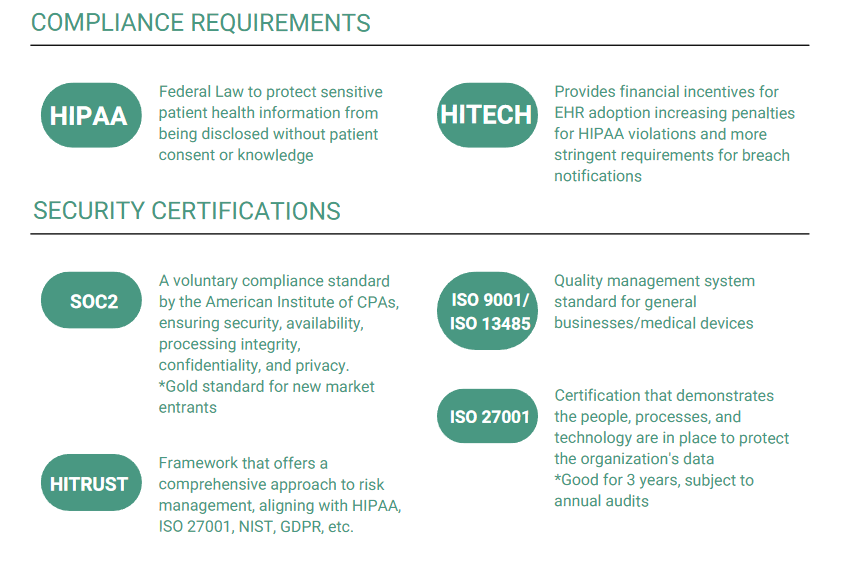
DATA COLLECTION
A well-defined data collection strategy is fundamental to successful integration. Startups must determine what data elements they will collect, how they will structure them, and how these elements align with industry standards. Ensuring standardized data formats is critical for interoperability, as variations in data capture methods can hinder seamless exchange between different EHR systems. Additionally, it is crucial to assign clear ownership for data accuracy and compliance monitoring, establishing protocols to maintain consistency and reliability in data entry and management.
KEY QUESTIONS
- Are the data elements custom or mapped to standards?
- Is the data captured through free text or discrete fields?
- Are there multiple fields for the same data element and how to differentiate?
- Is there a product owner of the data field and clear definitions of the data entered?
- Have there been recent changes to the data fields?
- Is the data documented in multiple different systems?
- Does someone monitor the compliance of these data elements?
DATA STORAGE AND OWNERSHIP
Determining how and where data is stored is another critical aspect of integration. Startups must decide between cloud-based and on-premise storage solutions, both of which come with their own security implications and regulatory requirements. Compliance with established security standards ensures the protection of sensitive patient information while defining ownership of data within the organization helps maintain accountability. By carefully structuring data storage and access protocols, startups can build a secure and scalable foundation for their digital health solutions.
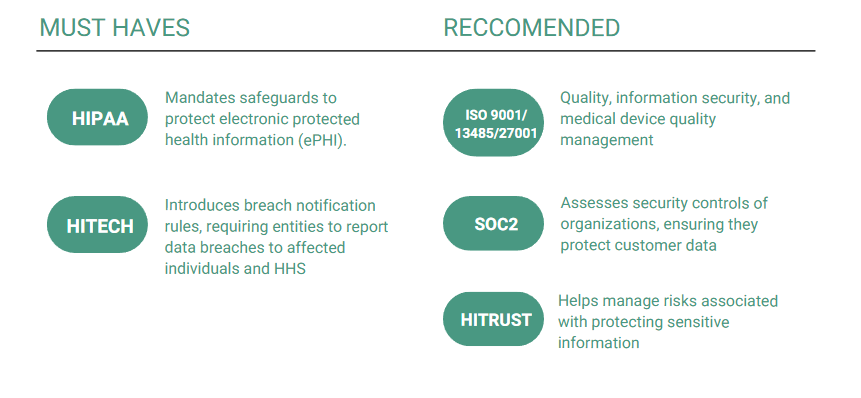
DATA TRANSFER
The ability to securely and efficiently transfer data between systems is a fundamental requirement for EHR integration. Startups must select the most appropriate transport standards based on their specific needs. Fast Healthcare Interoperability Resources (FHIR) is widely regarded as the gold standard for modern healthcare data exchange, providing a web-based framework for seamless interoperability. Other commonly used transport protocols include HL7, APIs, and secure direct messaging solutions. Ensuring adherence to these standards allows for smoother integration with healthcare providers’ existing systems while maintaining compliance with industry regulations.
DATA ANALYSIS AND REPORTING
Beyond simply storing and exchanging data, an effective EHR integration strategy should leverage data analytics to drive meaningful insights. The ability to analyze patient records, track key performance indicators, and generate actionable reports enhances the overall value proposition of a digital health solution. Furthermore, compliance with reporting requirements ensures that organizations meet regulatory expectations while optimizing healthcare delivery through data-driven decision-making.
PART 3: APPROACHES TO EHR INTEGRATION
There are multiple approaches to EHR integration, each with its own advantages and challenges. Startups should carefully assess their resources, business objectives, and target healthcare environments before selecting the most suitable method.
DATA ANALYSIS AND REPORTING
As an entry-level approach, manual workarounds involve methods such as e-faxing, secure file transfer protocol (SFTP) exchanges, and manual data entry. While these processes are labor-intensive and less scalable, they can be effective for early-stage validation and pilot programs with minimal financial investment. Many startups initially adopt these workarounds to test their solutions within healthcare settings before committing to more advanced integration methods.
THIRD PARTY INTEGRATION
For startups seeking a more efficient integration process without extensive in-house development, third-party integration platforms offer a practical solution. Companies such as Redox and Particle Health act as intermediaries, providing pre-built integration capabilities with major EHR vendors. This approach significantly reduces development time and accelerates the integration timeline by leveraging existing infrastructure and expertise. However, relying on external platforms also introduces dependencies that must be managed strategically, including ensuring continued compliance with evolving regulations and maintaining seamless system interoperability.
A successful example of third-party integration is HealthSnap, a digital health startup that has rapidly expanded by integrating with major EHR systems to support chronic disease management. By leveraging interoperability platforms, HealthSnap was able to streamline its data exchange processes, scale its operations to serve over 150 medical groups, and demonstrate improved clinical outcomes. This strategic integration enabled the company to expand its footprint and attract investment, highlighting the potential benefits for startups that effectively incorporate third-party solutions into their growth strategy.
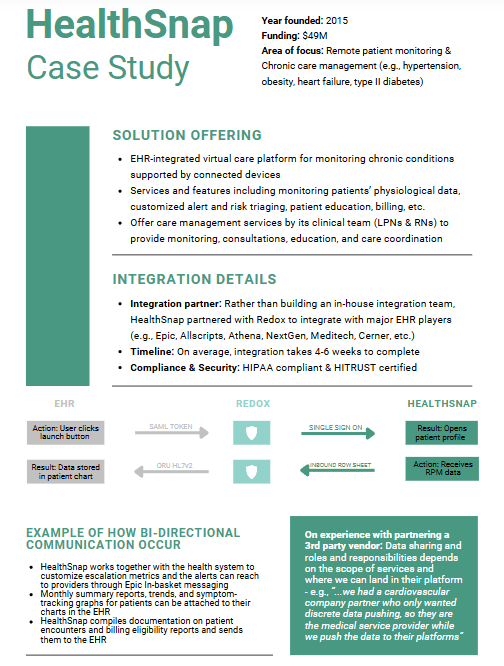
FULL INTEGRATION VIA APIs OR HL7
A fully integrated approach involves direct access to EHR systems using APIs or HL7 messaging protocols. This method provides the most seamless data exchange experience, allowing real-time interoperability between healthcare systems. While full integration offers significant long-term benefits, it requires substantial resources, technical expertise, and compliance with strict security and privacy regulations.
KEY DIFFERENCES IN HEALTHCARE DATA EXCHANGE
HL7: Legacy standard for institutional data exchange; requires persistent connections and transmits large datasets.
API: Enables on-demand data retrieval with enhanced security and user authentication.
FHIR: Modern standard combining API flexibility with structured healthcare data, ensuring better interoperability.
PART 4: IMPLEMENTATION PHASES
A phased approach to EHR integration helps ensure a structured and effective execution.
The process typically begins with planning and initiation, where business goals are defined, and key stakeholders are aligned. The design and development phase follows, during which workflows are mapped, and technical infrastructure is built. Training and execution play a vital role in ensuring users are well-equipped to navigate the system, followed by the go-live and optimization phase, where feedback is collected, and refinements are made.
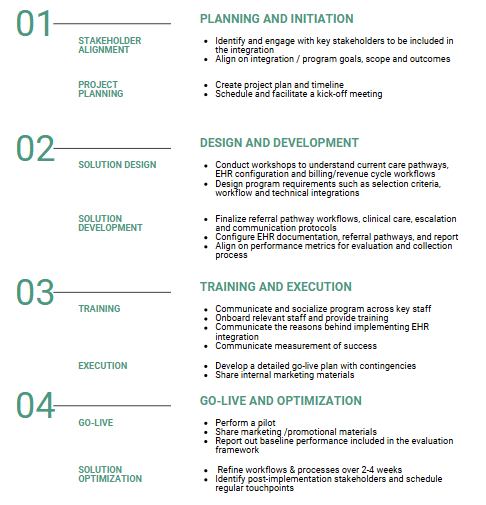
CONCLUSION
For startups entering the U.S. healthcare market, EHR integration and data security are not just technical necessities; they are critical determinants of success. In an industry where venture funding for digital health startups reached $10.1 billion across 497 deals last year—following an additional $1.8 billion raised in Q4 alone—investors and stakeholders are increasingly looking for companies with strong regulatory adherence, seamless technology integration, and clear market fit. Simply having an innovative solution is no longer enough; startups must ensure that their offerings align with the interoperability needs of healthcare providers while maintaining the highest standards of data security.
By adopting a strategic approach to EHR integration, startups can position themselves for long-term success. This involves selecting the right integration method, whether through manual workarounds, third-party platforms, or full API-based solutions, and ensuring strict adherence to compliance frameworks such as HIPAA and HITECH. A well-planned integration not only enhances workflow efficiency but also helps build credibility with healthcare institutions, making solutions more attractive to potential investors and partners.
Furthermore, as healthcare organizations continue to prioritize interoperability and data-driven decision-making, startups that offer seamless EHR integration will gain a competitive advantage. Successful integration fosters trust among providers, accelerates adoption, and creates long-term opportunities for scaling within the market. By focusing on regulatory compliance, security, and provider needs, startups can build solutions that not only survive but thrive, ensuring sustainable growth in the highly competitive U.S. healthcare landscape.
The opportunity is vast, and with the right approach, your startup can become an essential part of the evolving healthcare ecosystem. The time to act is now—position your company for sustainable growth and impact!
Accelerate your healthcare innovation today.
Contact Decimal Health to drive decisive results and conquer market challenges with precision.
SOURCES
-
Alder, S. (2025, January 2). What is the Hitech Act? 2025 update. The HIPAA Journal. https://www.hipaajournal.com/what-is-the-hitech-act/
-
BECKERS. (2016). 98% of digital health startups fail - here’s why. Becker’s Hospital Review. https://www.beckershospitalreview.com/healthcare-information-technology/98-of-digital-health-startups-fail-here-s-why.html
-
CB INSIGHTS. (2024, May 29). 483 startup failure post-mortems. https://www.cbinsights.com/research/startup-failure-post-mortem/
-
CDC.GOV. (2024, September 10). Health Insurance Portability and accountability act of 1996 (HIPAA). Centers for Disease Control and Prevention. https://www.cdc.gov/phlp/php/resources/health-insurance-portability-and-accountability-act-of-1996-hipaa.html
-
DahlbergI, N. (2024, February 22). HealthSnap closes $25M series B amid triple-digit growth. Refresh Miami. https://refreshmiami.com/news/healthsnap-closes-25m-series-b-amid-triple-digit-growth/
-
HL7 FHIR. (2023, March 26). HL7 FHIR Release 5. Overview - FHIR V5.0.0. https://www.hl7.org/fhir/overview.html
-
Krasniansky, A., Kaganoff, S., & Ramos, T. M. (2025, January 13). 2024 year-end market overview: Davids and goliaths: Rock health. Rock Health | We’re powering the future of healthcare. Rock Health is a seed and early-stage venture fund that supports startups building the next generation of technologies transforming healthcare. https://rockhealth.com/insights/2024-year-end-market-overview-davids-and-goliaths/
-
PARTICLE HEALTH. (2025). Particle health: Actionable data for Healthcare Innovators. Particle Health | Actionable Data for Healthcare Innovators. https://www.particlehealth.com/
-
REDOX. (2025). About redox. Redox. https://redoxengine.com/company
-
SANTEWARE. (2021, March 5). How is web api different from traditional HL7 and Fhir?: Santeware: Engineering healthcare data. Santeware. https://santeware.com/how-is-web-api-different-from-traditional-hl7-and-fhir/
-
Srini. (2024, January 4). Comparing NIST, ISO 27001, SOC 2, and other security standards and Frameworks. SOC 2, ISO 27001, HIPAA, NIST, Data Privacy, CMMC, PCI, GDPR. https://databrackets.com/comparing-nist-iso-27001-soc-2-and-other-security-standards-and-frameworks/
.png?width=125&height=125&name=logo_wt%20(3).png)

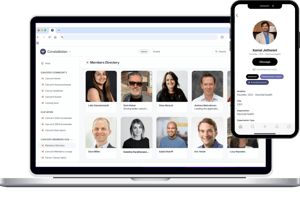
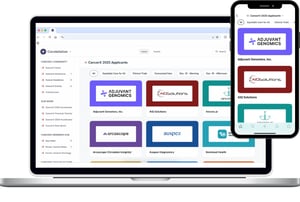



.png?width=300&name=CancerX%20Decimal%20Banner%20(2).png)